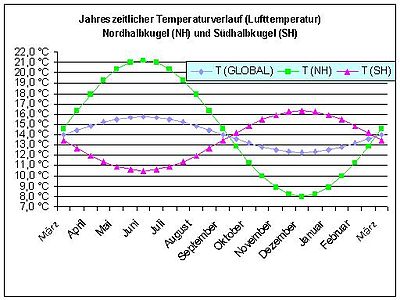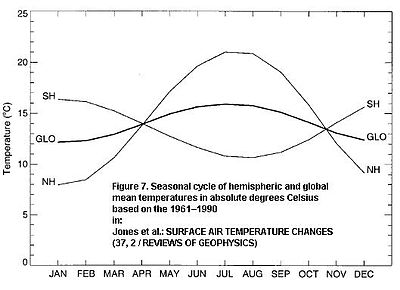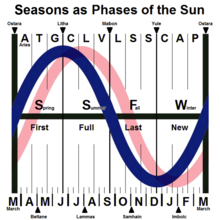
A | B | C | D | E | F | G | H | CH | I | J | K | L | M | N | O | P | Q | R | S | T | U | V | W | X | Y | Z | 0 | 1 | 2 | 3 | 4 | 5 | 6 | 7 | 8 | 9
| Part of a series on |
| Weather |
|---|
|
|
A season is a division of the year[1] based on changes in weather, ecology, and the number of daylight hours in a given region. On Earth, seasons are the result of the axial parallelism of Earth's tilted orbit around the Sun.[2][3][4] In temperate and polar regions, the seasons are marked by changes in the intensity of sunlight that reaches the Earth's surface, variations of which may cause animals to undergo hibernation or to migrate, and plants to be dormant. Various cultures define the number and nature of seasons based on regional variations, and as such there are a number of both modern and historical cultures whose number of seasons varies.
The Northern Hemisphere experiences most direct sunlight during May, June, and July (thus the traditional celebration of Midsummer in June), as the hemisphere faces the Sun. For the Southern Hemisphere it is instead in November, December, and January. It is Earth's axial tilt that causes the Sun to be higher in the sky during the summer months, which increases the solar flux. Due to seasonal lag, June, July, and August are the warmest months in the Northern Hemisphere while December, January, and February are the warmest months in the Southern Hemisphere.
In temperate and sub-polar regions, four seasons based on the Gregorian calendar are generally recognized: spring, summer, autumn (fall), and winter. Ecologists often use a six-season model for temperate climate regions which are not tied to any fixed calendar dates: prevernal, vernal, estival, serotinal, autumnal, and hibernal. Many tropical regions have two seasons: the rainy/wet/monsoon season and the dry season. Some have a third cool, mild, or harmattan season. "Seasons" can also be dictated by the timing of important ecological events such as hurricane season, tornado season, and wildfire season.[citation needed] Some examples of historical importance are the ancient Egyptian seasons—flood, growth, and low water—which were previously defined by the former annual flooding of the Nile in Egypt.
Seasons often hold special significance for agrarian societies, whose lives revolve around planting and harvest times, and the change of seasons is often attended by ritual. The definition of seasons is also cultural. In India, from ancient times to the present day, six seasons or Ritu based on south Asian religious or cultural calendars are recognised and identified for purposes such as agriculture and trade.
Causes and effects
Axial parallelism

The Earth's orbit exhibits approximate axial parallelism, maintaining its direction toward Polaris (the "North Star") year-round. This is one of the primary reasons for the Earth's seasons, as illustrated by the diagram to the right.[5][6][7][8] Minor variation in the direction of the axis, known as axial precession, takes place over the course of 26,000 years, and therefore is not noticeable to modern human civilization.
Axial tilt

The seasons result from the Earth's axis of rotation being tilted with respect to its orbital plane by an angle of approximately 23.4 degrees.[9] (This tilt is also known as "obliquity of the ecliptic".)
Regardless of the time of year, the northern and southern hemispheres always experience opposite seasons. This is because during summer or winter, one part of the planet is more directly exposed to the rays of the Sun than the other, and this exposure alternates as the Earth revolves in its orbit. For approximately half of the year (from around March 20 to around September 22), the Northern Hemisphere tips toward the Sun, with the maximum amount occurring on about June 21. For the other half of the year, the same happens, but in the Southern Hemisphere instead of the Northern, with the maximum around December 21. The two instants when the Sun is directly overhead at the Equator are the equinoxes. Also at that moment, both the North Pole and the South Pole of the Earth are just on the terminator, and hence day and night are equally divided between the two hemispheres. Around the March equinox, the Northern Hemisphere will be experiencing spring as the hours of daylight increase, and the Southern Hemisphere is experiencing autumn as daylight hours shorten.
The effect of axial tilt is observable as the change in day length and altitude of the Sun at solar noon (the Sun's culmination) during the year. The low angle of Sun during the winter months means that incoming rays of solar radiation are spread over a larger area of the Earth's surface, so the light received is more indirect and of lower intensity. Between this effect and the shorter daylight hours, the axial tilt of the Earth accounts for most of the seasonal variation in climate in both hemispheres.
-
Illumination of Earth by Sun at the northern solstice.
-
Illumination of Earth by Sun at the southern solstice.
-
Illumination of Earth at each change of astronomical season
-
Animation of Earth as seen daily from the Sun looking at UTC+02:00, showing the solstice and changing seasons.
-
Two images showing the amount of reflected sunlight at southern and northern summer solstices respectively (watts / m2).
Elliptical Earth orbit
Compared to axial parallelism and axial tilt, other factors contribute little to seasonal temperature changes.[4] The seasons are not the result of the variation in Earth's distance to the Sun because of its elliptical orbit.[10] In fact, Earth reaches perihelion (the point in its orbit closest to the Sun) in January, and it reaches aphelion (the point farthest from the Sun) in July, so the slight contribution of orbital eccentricity opposes the temperature trends of the seasons in the Northern Hemisphere.[11] In general, the effect of orbital eccentricity on Earth's seasons is a 7% variation in sunlight received.
Orbital eccentricity can influence temperatures, but on Earth, this effect is small and is more than counteracted by other factors; research shows that the Earth as a whole is actually slightly warmer when farther from the sun. This is because the Northern Hemisphere has more land than the Southern, and land warms more readily than sea.[11] Any noticeable intensification of southern winters and summers due to Earth's elliptical orbit is mitigated by the abundance of water in the Southern Hemisphere.[12]
Maritime and hemispheric
Seasonal weather fluctuations (changes) also depend on factors such as proximity to oceans or other large bodies of water, currents in those oceans, El Niño/ENSO and other oceanic cycles, and prevailing winds.
In the temperate and polar regions, seasons are marked by changes in the amount of sunlight, which in turn often causes cycles of dormancy in plants and hibernation in animals. These effects vary with latitude and with proximity to bodies of water. For example, the South Pole is in the middle of the continent of Antarctica and therefore a considerable distance from the moderating influence of the southern oceans. The North Pole is in the Arctic Ocean, and thus its temperature extremes are buffered by the water. The result is that the South Pole is consistently colder during the southern winter than the North Pole during the northern winter.
The seasonal cycle in the polar and temperate zones of one hemisphere is opposite to that of the other. When it is summer in the Northern Hemisphere, it is winter in the Southern, and vice versa.
Tropics

The tropical and (to a lesser degree) subtropical regions see little annual fluctuation of sunlight and temperature due Earth's moderate 23.4-degree tilt being insufficient to appreciably affect the strength of the sun's rays annually. The slight differences between the solstices and the equinoxes cause seasonal shifts along a rainy low-pressure belt called the Intertropical Convergence Zone (ICZ). As a result, the amount of precipitation tends to vary more dramatically than the average temperature. When the ICZ is north of the Equator, the northern tropics experience their wet season while the southern tropics have their dry season. This pattern reverses when the ICZ migrates to a position south of the Equator.
Mid-latitude thermal lag
In meteorological terms, the solstices (the maximum and minimum insolation) do not fall in the middles of summer and winter. The heights of these seasons occur up to 7 weeks later because of seasonal lag. Seasons, though, are not always defined in meteorological terms.
In astronomical reckoning by hours of daylight alone, the solstices and equinoxes are in the middle of the respective seasons. Because of seasonal lag due to thermal absorption and release by the oceans, regions with a continental climate, which predominate in the Northern Hemisphere, often consider these four dates to be the start of the seasons as in the diagram, with the cross-quarter days considered seasonal midpoints. The length of these seasons is not uniform because of Earth's elliptical orbit and its different speeds along that orbit.[13]
Four-season reckoning

Most calendar-based partitions use a four-season model to demarcate the warmest and coldest seasons, which are further separated by two intermediate seasons. Calendar-based reckoning defines the seasons in relative rather than absolute terms, so the coldest quarter-year is considered winter even if floral activity is regularly observed during it, despite the traditional association of flowers with spring and summer. The major exception is in the tropics where, as already noted, the winter season is not observed.
The four seasons have been in use since at least Roman times, as in Rerum rusticarum of Varro[14] Varro says that spring, summer, autumn, and winter start on the 23rd day of the sun's passage through Aquarius, Taurus, Leo, and Scorpio, respectively. Nine years before he wrote, Julius Caesar had reformed the calendar, so Varro was able to assign the dates of February 7, May 9, August 11, and November 10 to the start of spring, summer, autumn, and winter.
Official
As noted, a variety of dates and even exact times are used in different countries or regions to mark changes of the calendar seasons. These observances are often declared "official" within their respective areas by the local or national media, even when the weather or climate is contradictory.[15] These are mainly a matter of custom and not generally proclaimed by governments north or south of the equator for civil purposes.[16][17]
Meteorological

Meteorological seasons are reckoned by temperature, with summer being the hottest quarter of the year and winter the coldest quarter of the year. In 1780 the Societas Meteorologica Palatina (which became defunct in 1795), an early international organization for meteorology, defined seasons as groupings of three whole months as identified by the Gregorian calendar.[18] According to this definition, for temperate areas in the northern hemisphere, spring begins on 1 March, summer on 1 June, autumn on 1 September, and winter on 1 December. For the southern hemisphere temperate zone, spring begins on 1 September, summer on 1 December, autumn on 1 March, and winter on 1 June.[19][20] In Australasia the meteorological terms for seasons apply to the temperate zone that occupies all of New Zealand, New South Wales, Victoria, Tasmania, the south-eastern corner of South Australia and the south-west of Western Australia, and the south east Queensland areas south of Brisbane.
| Northern hemisphere | Southern hemisphere | Start date | End date |
|---|---|---|---|
| Winter | Summer | 1 December | 28 February (29th if leap year) |
| Spring | Autumn | 1 March | 31 May |
| Summer | Winter | 1 June | 31 August |
| Autumn | Spring | 1 September | 30 November |
In Sweden and Finland, meteorologists and news outlets use the concept of thermal seasons, which are defined based on mean daily temperatures.[21] The beginning of spring is defined as when the mean daily temperature permanently rises above 0 °C. The beginning of summer is defined as when the temperature permanently rises above +10 °C, autumn as when the temperature permanently falls below +10 °C, and winter as when the temperature permanently falls below 0 °C. In Finland, "permanently" is defined as when the mean daily averaged temperature remains above or below the defined limit for seven consecutive days. (In Sweden the number of days ranges from 5 to 7 depending on the season.) This implies two things:
- the seasons do not begin on fixed dates and must be determined by observation and are known only after the fact,
- the seasons begin on different dates in different parts of the country.
| Surface air temperature | |
|---|---|
 |
 |
| Diagram was calculated (abscisse: the 21st of each month). Calculation based on data published by Jones et al.[22] |
The picture shows Figure 7 as published by Jones et al.[22] |
The India Meteorological Department (IMD) designates four climatological seasons:[23]
- Winter, occurring from December to February. The year's coldest months are December and January, when temperatures average around 10–15 °C (50–59 °F) in the northwest; temperatures rise as one proceeds toward the equator, peaking around 20–25 °C (68–77 °F) in mainland India's southeast.
- Summer or pre-monsoon season, lasting from March to May. In western and southern regions, the hottest month is April; for northern regions of India, May is the hottest month. Temperatures average around 32–40 °C (90–104 °F) in most of the interior.
- Monsoon or rainy season, lasting from June to September. The season is dominated by the humid southwest summer monsoon, which slowly sweeps across the country beginning in late May or early June. Monsoon rains begin to recede from North India at the beginning of October. South India typically receives more rainfall.
- Post-monsoon or autumn season, lasting from October to November. In the northwest of India, October and November are usually cloudless. Tamil Nadu receives most of its annual precipitation in the northeast monsoon season.
In China, a common temperature-based reckoning holds that it is winter for the period when temperatures are below 10°C on average and summer for the period when temperatures are above 22°C on average. This means that areas with relatively extreme climates (such as the Paracel Islands and parts of the Tibetan plateau) may be said to have summer all year round or winter all year round.[24]
Astronomical
| event | equinox | solstice | equinox | solstice | ||||
|---|---|---|---|---|---|---|---|---|
| month | March[27] | June[28] | September[29] | December[30] | ||||
| year | day | time | day | time | day | time | day | time |
| 2019 | 20 | 21:58 | 21 | 15:54 | 23 | 07:50 | 22 | 04:19 |
| 2020 | 20 | 03:50 | 20 | 21:43 | 22 | 13:31 | 21 | 10:03 |
| 2021 | 20 | 09:37 | 21 | 03:32 | 22 | 19:21 | 21 | 15:59 |
| 2022 | 20 | 15:33 | 21 | 09:14 | 23 | 01:04 | 21 | 21:48 |
| 2023 | 20 | 21:25 | 21 | 14:58 | 23 | 06:50 | 22 | 03:28 |
| 2024 | 20 | 03:07 | 20 | 20:51 | 22 | 12:44 | 21 | 09:20 |
| 2025 | 20 | 09:02 | 21 | 02:42 | 22 | 18:20 | 21 | 15:03 |
| 2026 | 20 | 14:46 | 21 | 08:25 | 23 | 00:06 | 21 | 20:50 |
| 2027 | 20 | 20:25 | 21 | 14:11 | 23 | 06:02 | 22 | 02:43 |
| 2028 | 20 | 02:17 | 20 | 20:02 | 22 | 11:45 | 21 | 08:20 |
| 2029 | 20 | 08:01 | 21 | 01:48 | 22 | 17:37 | 21 | 14:14 |
Astronomical timing as the basis for designating the temperate seasons dates back at least to the Julian Calendar used by the ancient Romans. As mentioned above, Varro wrote that spring, summer, autumn, and winter start on the 23rd day of the sun's passage through Aquarius, Taurus, Leo, and Scorpio, respectively, and that (in the Julian Calendar) these days were February 7, May 9, August 11, and November 10. He points out that the lengths are not equal, being 91 (in non-leap years), 94, 91, and 89 days for spring, summer, autumn, and winter, respectively.[14] The midpoints of these seasons were March 24 or 25, June 25, September 25 or 26, and December 24 or 25, which are near to the equinoxes and solstices of his day.
Pliny the Elder, in his Natural History, mentions the two equinoxes and the two solstices and gives the lengths of the intervals (values which were fairly correct in his day but are no longer very correct because the perihelion has moved from December into January). He then defines the seasons of autumn, winter, spring, and summer as starting half-way through these intervals.[31] He gives "the eighth day to the Kalends of January" (December 25) as the date of the winter solstice, though actually it occurred on the 22nd or 23rd at that time.[32]
Nowadays the astronomical timing has winter starting at the winter solstice, spring at the spring equinox, and so on. This is used worldwide, although some countries like Australia, New Zealand,[33] Pakistan and Russia prefer to use meteorological reckoning. The precise timing of the seasons is determined by the exact times of the sun reaching the tropics of Cancer and Capricorn for the solstices and the times of the sun's transit over the equator for the equinoxes, or a traditional date close to these times.[34]
The following diagram shows the relation between the line of solstice and the line of apsides of Earth's elliptical orbit. The orbital ellipse (with eccentricity exaggerated for effect) goes through each of the six Earth images, which are sequentially the perihelion (periapsis—nearest point to the sun) on anywhere from 2 January to 5 January, the point of March equinox on 19, 20 or 21 March, the point of June solstice on 20 or 21 June, the aphelion (apoapsis—farthest point from the sun) on anywhere from 3 July to 6 July, the September equinox on 22 or 23 September, and the December solstice on 21 or 22 December.

These "astronomical" seasons are not of equal length, because of the elliptical nature of the orbit of the Earth, as discovered by Johannes Kepler. From the March equinox it currently takes 92.75 days until the June solstice, then 93.65 days until the September equinox, 89.85 days until the December solstice and finally 88.99 days until the March equinox. Thus the time from the March equinox to the September equinox is 7.56 days longer than from the September equinox to the March equinox.
Variation due to calendar misalignment
The times of the equinoxes and solstices are not fixed with respect to the modern Gregorian calendar, but fall about six hours later every year, amounting to one full day in four years. They are reset by the occurrence of a leap year. The Gregorian calendar is designed to keep the March equinox no later than 21 March as accurately as is practical. Also see: Gregorian calendar seasonal error.
The calendar equinox (used in the calculation of Easter) is 21 March, the same date as in the Easter tables current at the time of the Council of Nicaea in AD 325. The calendar is therefore framed to prevent the astronomical equinox wandering onto 22 March. From Nicaea to the date of the reform, the years 500, 600, 700, 900, 1000, 1100, 1300, 1400, and 1500, which would not have been leap years in the Gregorian calendar, amount to nine extra days, but astronomers directed that ten days be removed. Because of this, the (proleptic) Gregorian calendar agrees with the Julian calendar in the third century of the Christian era, rather than in the fourth.
Currently, the most common equinox and solstice dates are March 20, June 21, September 22 or 23, and December 21; the four-year average slowly shifts to earlier times as a century progresses. This shift is a full day in about 128 years (compensated mainly by the century "leap year" rules of the Gregorian calendar); as 2000 was a leap year, the current shift has been progressing since the beginning of the last century, when equinoxes and solstices were relatively late. This also means that in many years of the twentieth century, the dates March 21, June 22, September 23, and December 22 were much more common, so older books teach (and older people may still remember) these dates.
All the times are given in UTC (roughly speaking, the time at Greenwich, ignoring British Summer Time). People living farther to the east (Asia and Australia), whose local times are in advance, see the astronomical seasons apparently start later; for example, in Tonga (UTC+13), an equinox occurred on September 24, 1999, a date on which the equinox will not fall again until 2103. On the other hand, people living far to the west (America), whose clocks run behind UTC, may experience an equinox as early as March 19.
Change over time
Over thousands of years, the Earth's axial tilt and orbital eccentricity vary (see Milankovitch cycles). The equinoxes and solstices move westward relative to the stars while the perihelion and aphelion move eastward. Thus, ten thousand years from now Earth's northern winter will occur at aphelion and northern summer at perihelion. The severity of seasonal change — the average temperature difference between summer and winter in location — will also change over time because the Earth's axial tilt fluctuates between 22.1 and 24.5 degrees.
Smaller irregularities in the times are caused by perturbations of the Moon and the other planets.
Solar

Solar timing is based on insolation in which the solstices and equinoxes are seen as the midpoints of the seasons. This was the case with the seasons described by the Roman scholar Varro (see above). It was the method for reckoning seasons in medieval Europe, especially by the Celts, and is still ceremonially observed in Ireland and some East Asian countries. Summer is defined as the quarter of the year with the greatest insolation and winter as the quarter with the least.
The solar seasons change at the cross-quarter days, which are about 3–4 weeks earlier than the meteorological seasons and 6–7 weeks earlier than seasons starting at equinoxes and solstices. Thus, the day of greatest insolation is designated "midsummer" as noted in William Shakespeare's play A Midsummer Night's Dream, which is set on the summer solstice. On the Celtic calendar, the start of the seasons corresponds to four Pagan agricultural festivals - the traditional first day of winter is 1 November (Samhain, the Celtic origin of Halloween); spring starts 1 February (Celtic Imbolc); summer begins 1 May (Beltane, the Celtic origin of May Day); the first day of autumn is 1 August (Celtic Lughnasadh).
| Season | Start date | End date |
|---|---|---|
| Winter | 1 November (All Saints' Day) | 31 January |
| Spring | 1 February (St. Brigid's Day) | 30 April |
| Summer | 1 May (May Day) | 31 July |
| Autumn | 1 August (Lughnasadh) | 31 October (Hallowe'en) |
Solar terms
The traditional calendar in China has 4 seasons based on 24 periods known as solar terms.[35] The four seasons chūn (春), xià (夏), qiū (秋), and dōng (冬)—universally translated as "spring", "summer", "autumn", and "winter"—each center on the respective solstice or equinox. Astronomically, the seasons are said to begin on Lichun (立春, "the start of spring") on about 4 February, Lixia (立夏) on about 6 May, Liqiu (立秋) on about 8 August, and Lidong (立冬) on about 7 November. These dates were not part of the traditional lunar calendar, and moveable holidays such as Chinese New Year and the Mid-Autumn Festival are more closely associated with the seasons. It forms the basis of other such systems in East Asian lunisolar calendars.
Six-season reckoning
Some calendars in south Asia use a six-season partition where the number of seasons between summer and winter can number from one to three. The dates are fixed at even intervals of months.
In the Hindu calendar of tropical and subtropical India, there are six seasons or Ritu that are calendar-based in the sense of having fixed dates: Vasanta (spring), Grīshma (summer), Varsha (monsoon), Sharat (autumn), Hemanta (early winter), and Shishira (prevernal or late winter). The six seasons are ascribed to two months each of the twelve months in the Hindu calendar. The rough correspondences are:
| Hindu season | Start | End | Hindu months | Mapping to English names |
|---|---|---|---|---|
| Vasanta | Mid-March | Mid-May | Chaitra, Vaishakha | spring |
| Grīshma | Mid-May | Mid-July | Jyeshtha, Ashadha | summer |
| Varshā | Mid-July | Mid-September | Shraavana, Bhadrapada | monsoon |
| Sharat | Mid-September | Mid-November | Ashvin, Kartika | autumn |
| Hemanta | Mid-November | Mid-January | Maargashirsha, Pushya | early winter or late autumn |
| Shishira | Mid-January | Mid-March | Magh, Phalguna | prevernal or late winter |
The Bengali Calendar is similar but differs in start and end times. It has the following seasons or ritu:






